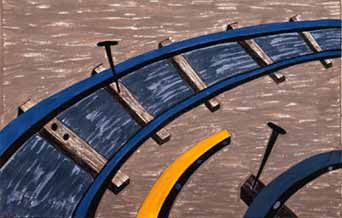|
|
 |
 |
 |

They also worked in large numbers on
the railroad.
The Migration of the Negro, panel
38, 1940-41. Casein tempera on hardboard, 12 x 18 in. (30.5 x 45.7
cm). The Museum of Modern Art, New York; gift of Mrs. David M. Levy
Artwork © Gwendolyn Knight Lawrence, courtesy of the Jacob and
Gwendolyn Lawrence Foundation
Click here to view a larger image |
| |
|
 |
Railroad companies
regularly issued their employees passes for free travel, and many
southern blacks used their passes to migrate north. Once in the North,
ninety percent of southern migrants worked as unskilled laborers.
Many worked long hours on the railroads. The jobs available to southern
migrants were often backbreaking and monotonous, with low pay, and
little chance for advancement. Blacks were excluded from labor unions,
and they had few means to rectify their working situation.
Jacob Lawrence cropped and framed this image to engage the viewer
directly in the scene. Nails are poised in the tracks as if to imply
more work. There is no end to the track–or the labor–in
sight. Together the metal, wood, and earth create a harsh landscape.
LABOR
1. The use of physical or mental effort, especially when difficult
or compulsory.
2. Human activity that provides the goods or services in an economy.
3. The services performed by workers for wages as distinct from those
performed for profit.
WORK
1. An activity in which one uses strength or faculties to do or perform
something.
2. The physical or mental effort to overcome obstacles and achieve
an objective or result. |
|
|

What do you think are some of the differences
between work and labor?
• Think about the kinds of work that you do, such as making food, doing
homework, or fixing your bike. Try to capture the work in a snapshot vision
as Jacob Lawrence has done, without including yourself (the worker). Focus
attention on the tools needed to do this kind of work. Illustrate the mood
of the activity. Take a photograph or make a drawing. Include close-ups,
details, and expressive colors.
|









